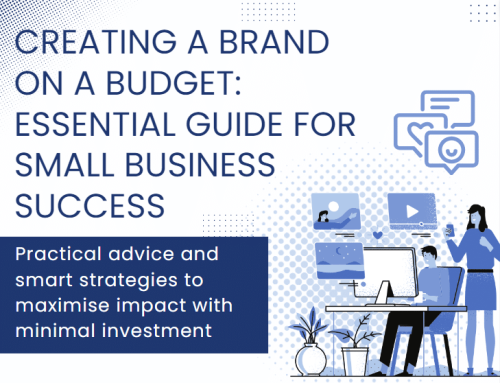Branding is more than a logo: 5 steps for growing your business into a brand
 How much is a logo?
How much is a logo?
Any graphic designer worth their Mac will tell you that this is often the first question most business owners ask as they set out on their branding journey.
But as a business coach, I mentor my clients that growing a business into a brand takes more than just a new logo or website. It’s about having a clear understanding of everything your business stands for, who you want to serve and what signposts to set out in order to lead those people towards your business.
Thinking about branding this way makes it easier to see why your brand is critical to your business’ growth. When your branding resonates with your ideal customer it goes a long way towards attracting the right people to your business.
A strong brand helps you qualify leads
An effective brand is just as much about repelling the wrong people from your business as it is about attracting the right ones. During my time as a business adviser, I’ve seen this idea make some business owners very nervous; it’s common to want to appeal to everybody.
I mentor clients that there’s no point driving more traffic to your business or website if that traffic isn’t likely to convert into sales. Effective branding may lead to slightly less people showing up on your doorstep (virtual or otherwise) but, since they’re the right people, your conversion rate will definitely increase.
Branding projects often start as a reaction to something else
When a business owner decides to kick off a branding (or re-branding) project, this often suggests to me, as an experienced business coach, that they’re at a tipping point in their business.
It might be that they’ve significantly grown their team, landed a big new account or moved out of their home office and into to a more permanent office or workspace. These triggers often make business owners look at their brand (or lack of) with fresh eyes. Suddenly, their website makes them cringe, or they become concerned that the logo they had designed on the cheap doesn’t really say anything about their business.
Back up the bus…
As a coach, I mentor clients not to rebrand as a knee-jerk reaction. Before you spend a whole lot of money on re-designing your logo or a whizz-bang new website, ask yourself:
- Why am I branding/re-branding?
- What’s the strategy?
- How will this activity contribute to the growth of my business?
I have seen far too many branding projects that started because a business owner was simply tired of their current brand. The fact is, you should always check in with yourself and your customers to figure out if what (if anything) needs to change. As they say, if it ain’t broke…
There are, however, business problems that have their roots in branding problems. If you believe that this is the case in your business, then taking a strategic approach to the exercise will save you from sinking money into a re-brand that ends up going nowhere.
5 steps to branding your business
One: Take your resting brand pulse
How is your brand tracking right now? What’s working? What needs to improve? There’s only one way to find out: research. You’ll need to establish a baseline for how your brand is performing today so that you can test any changes you make.
That devil is in the data – sales records, Google Analytics, customer feedback, surveys and focus groups etc. You can conduct this research yourself, or pay a consultant to do it for you. But either way, it needs to be done. Assumption is the quickest way to waste your branding budget.
Two: Define your ‘Who’
Simon Sinek always says to start with your ‘Why’. However, when it comes to anchoring your branding project, you must place equal importance on defining your ‘Who’ – your target audience.
The better you can understand this group of people – who they are, what they want/need, the problems they are trying to solve, what motivates them etc – the more successful you will be at building a brand that appeals to them.
Three: Take note of the competition
Look around at your direct competitors. What are the key messages they put out there about themselves? How do they make themselves stand out? This isn’t about imitating other brands – in fact, it’s an exercise in working out what you are not going to do.
Four: uncover your unique selling proposition (USP)
The next logical step is to figure out what makes your brand distinctive; what does your business do better than everyone else? Our guide to uncovering your USP should give you a few ideas about how you can discover the recipe to your own ‘secret sauce’.
Pro tip: Remember the USP golden rule – it has to matter to your customers. As a business coach, I mentor my clients that if their USP won’t make their customers happier, smarter, healthier, richer, safer, more secure, more attractive or more successful, then they need to keep digging until they uncover one that does.
Five: start building your brand
Now is around the time you might start working on a logo. But before we get carried away, it’s important to understand that how your brand looks represents just one piece of the brand identity puzzle. Your business actually has three brand identities.
Marketing expert, Mike Kim, offers a nice framework that explains the three separate brand identities that make up your overall brand:
- Visual identity – how your brand looks (ie your logo, brand colours, fonts, the images you use etc)
- Verbal identity – how your brand sounds (ie your brand messages, the kinds of words and phrases you use, as well as the pacing, personality and tone of voice you use in your copy)
- Value identity – this is about your value positioning with the market (ie are you a high-end or budget option? Do you offer discounts etc.)
Mike suggests that these three brand identities act like a three-legged stool. If one of them is out of alignment, the whole brand becomes unstable.
The often forgotten sixth step of branding
Test. Test. Test. Remember back at step one, I said you’d need a baseline to measure any changes against? This is why. Beyond your first few years in business, your brand is something that lives and grows in the minds of your customers. They develop a certain set of ideas, values and beliefs about your brand that comes from their personal experiences of doing business with you. The only way to ensure that your brand is healthy and aligned with your target audience is to regularly check-in with your customers.
Remember that brand consistency is key
Once you have your brand strategy in place, you need to roll it out across your whole business. Every time you communicate with your customers, across every platform (ie website, social media, in person – even your outgoing phone message) your messaging and design should have its roots in your brand strategy. That’s what marketing people mean when they bandy about the phrase “on brand”.
You’ll never be done with your brand strategy
As a coach, I mentor business owners that managing their brand is an ongoing project. Your business’ visual image, verbal messaging and value positioning may require the occasional tune-up to meet changing customer needs and shifts in the market. It is only through regular brand-health testing (checking-in with the people you serve) that you can ensure that your business grows up into a brand that will continue to appeal to your customers; unquestionably an important factor in your business’ overall success.
—




